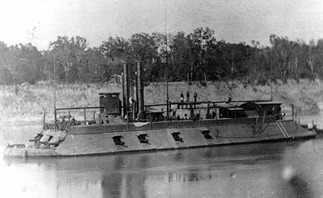Engagement at Charles City–Explosion of the Boiler of the Mound City–Terrible Loss of Life–Total Defeat of the Rebels.
 Memphis, June 19.–An expedition, composed of the gun-boats St. Louis, Lexington, Conestoga and Mound City, with transports carrying the Forty-third and Forty-sixth Indiana Regiments, under Colonel Fitch, was sent hence some days since to remove the obstructions from the White River. On the 17th the expedition reached St. Charles, 85 miles from the mouth of the river, where the Rebels had erected a battery.
Memphis, June 19.–An expedition, composed of the gun-boats St. Louis, Lexington, Conestoga and Mound City, with transports carrying the Forty-third and Forty-sixth Indiana Regiments, under Colonel Fitch, was sent hence some days since to remove the obstructions from the White River. On the 17th the expedition reached St. Charles, 85 miles from the mouth of the river, where the Rebels had erected a battery.
An engagement ensued, lasting an hour and a half. While the gun boats engaged the batteries, the troops under Colonel Fitch landed a short distance below and proceeded to storm the place. During the cannonading, a ball entered the boiler of the gun-boat Mound City, causing a fearful explosion and loss of life. The crew consisted of one hundred and seventy-five, of whom one hundred and twenty-five were killed and wounded. The following officers are among the killed:–John Kenzie, Jan Scoville, John Green, Henry R. Brown, Jos. Nixon and John Cox. Captain Kelty, the Flag Officer, was badly scalded, but it is thought will recover.
Colonel Fitch’s charge on the battery was a perfect success, driving the enemy out at the point of the bayonet. The Rebel loss is 125 killed and wounded, and 30 prisoners. General Halleck has occupied Holly Springs.
Chicago, June 21.–The following fuller account of the fight with the Rebel batteries on White River has just been received.
Memphis, June 19.–The gun-boat Conestoga has arrived with despatches containing the particulars of the engagement at the Rebel fortifications below St. Charles.
On the 17th, the gun-boats St. Louis, Mound City, Lexington, and Conestoga, and transport New National, having on board the Forty-sixth Indiana Regiment, Col. Fitch, which left here a week ago to open communication with Gen. Curtis’ army, and remove the obstructions from White River, ascended that stream. The gun-boat Mound City, Captain Kelty commanding, was about a mile and a half in advance. In a bend of the river near St. Charles, two concealed batteries opened on the Mound City. Her decks were immediately cleared for action, and as soon as the range of the works was obtained, the guns opened fire.
Capt. Kelty signaled to Col. Fitch to land his force below the fort, which was successfully accomplished. The Lexington and St. Louis shelled the woods, under cover of which Col. Fitch gained the rear of the Rebel position.
At this juncture a ball from a siege gun on the bluff struck the forward and port side of the Mound City, penetrating the casements and passing through the steam drum. The vessel was filled with the escaping vapor, and nearly every one on board was scalded; only twenty-three of the officers and crew, out of one hundred and seventy-five, escaped from injuries. The scene which ensued was horrible. Many of the crew, frantic with pain, jumped overboard, and some of them were drowned. Boats from the Conestoga, which was coming up at the time to support the Mound City, were sent to their relief; but the Rebels fired on the men in the water with grape and canister from their field pieces, murdering most of those who were attempting to escape.
Being apprised of the state of affairs in the river, Colonel Fitch’s regiment pushed forward and carried the fort by storm at the point of the bayonet. The Rebel works consisted of two batteries, the lower one mounting six field pieces, and the upper one three heavy siege guns, manned by from 400 to 500 men, under command of Colonel Frye, late of the United States Navy. About 200 Rebels are said to have escaped, over 150 are reported killed and wounded, and thirty taken prisoners.
Among the prisoners is Colonel Frye, who was wounded in the shoulder. He has been brought to Memphis by the Conestoga.
Captain Kelly, of the Mound City, was severely scalded about the face and hands. He will recover. Second Master Hearth, Third Master Kinzie, Fourth Master Scoville, Master’s Mate H. R. Browne, Paymaster —–, Chief Engineer John Cox, and Assistant Engineers John McAffee and Hollingsworth were killed. Pilot Chas. Young was severely scalded, and is reported to have since died. Surgeon Jones and Carpenter Manning were slightly scalded. From eighty to one hundred of our sailors have already been buried, and over twenty are missing.
Colonel Fitch, report[ed that] but few of his men were wounded and none [died], and but for the unfortunate accident on the Mound City, the Rebel works would have been carried without loss on our side. She can easily be repaired. The Flag Officer has sent to Cairo for another crew. The Rebels have obstructed the channel above, by sinking two large steamboats and a gun-boat, believed to be the Maypol.
Philadelphia Inquirer
Monday, June 23, 1862


